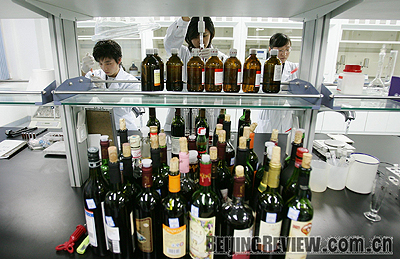|

QUALITY CONTROL: Staff work in a laboratory at the Beijing Municipal Center For Food Safety Monitoring. The center was created under the Beijing Food Safety Administration in 2004 to provide technical support for food safety at the 2008 Olympics
Baoshan, a small town in Huairou District where the average temperature is 3 to 4 degrees centigrade lower than in the urban area due to its elevation of more than 300 meters, is the site of Beijing's Olympic Tomato Base.
Although tomatoes are a summer vegetable, they have very strict temperature demands. Temperatures that are too high or too low will affect the flavor and color of the tomatoes.
Considering this, researchers at the Beijing Agro-Technical Extension and Service Center designed a special tomato shed. It has a plastic cover found on most vegetable sheds and also two layers of gauze covering, one black for shutting out sunlight and the other white for preventing pests.
"Technically, we can completely control the temperature for the growth of the tomatoes," said Si Lishan, Vice Director of the center. "But the cost of lowering the temperature is relatively high, so it is better to choose a mountainous area with a naturally lower temperature as a planting base for tomatoes."
"In order to keep the natural flavor of tomatoes and ensure their safety for people's health, we don't spray any pesticides on them," he added.
At present, vegetables in Beijing's markets are mainly targeted at Chinese consumers, but the city's Olympic guests will come from many different parts of the world. The Beijing Agro-Technical Extension and Service Center established experimental planting bases for more than 170 types of foreign vegetables in order to provide the visitors with a taste of home.
After initial research of more than three years, the center and related institutes picked several planting bases, most of which are within 300 km of Beijing to help ensure the freshness, quantity, safety and quality of the food.
All the seeds used to grow the Olympic vegetables are from Yanqing District in Beijing. Every Olympic vegetable, from the seed to the dinner table, is digitally recorded with very detailed information about its origin, fertilizer application and where it was processed. Finally, the vegetables are packed into categories and put into refrigerated rooms labeled with authentication codes.
Managing animals is a much more difficult task. "From feeding, disease-prevention, to the butcher, we have to adopt more technologies to manage them," said Shi Yinsong, who works in the Marketing Department of Kingkey Group, the pork supplier to the Beijing Olympics. Everyday, a professional nutritionist mixes feed for the pigs, every ingredient of which is totally organic.
The animals' shelters are equipped with monitors that alert staff to any unusual situations and record digital data on the livestock.
All livestock has been implanted with a radio frequency identification (RFID) to record information on its origin and growing process. Each animal's RFID is unique. After an animal is killed, it is given a new identification number that records its butchery information. When the animal's meat is cut into pieces, each piece is given yet another identification code, allowing consumers to check information about it at machines in the supermarket.
This system is capable of controlling the quality of food from the production base to the processing factory and finally the Olympic Village. The Beijing Food Safety Office has already established a data center for the Olympic Village and food data can also be checked at other supermarkets around the city.
The safety checking system was put into use during the Good Luck Beijing competitions last year. Beijing has also set up the food safety monitoring system in both Chinese and English.
"In order to ensure food safety during the Olympics, administrative organs at all levels will implement the monitoring system to track the whole circulation process of the food," said Sun Wenxu, Director of the Consumers' Rights and Interests Protection Bureau of the State Administration for Industry and Commerce. Sun added that major measures to ensure food safety include monitoring food processing from the source to the Olympic Village and formulating food safety regulations for 345 species of Olympic food.
During the Olympics, when athletes enter a restaurant in the Olympic Village, the access control system will automatically identify them and record the vegetables they choose. If there are problems with the vegetables, their digital records will identify them. |